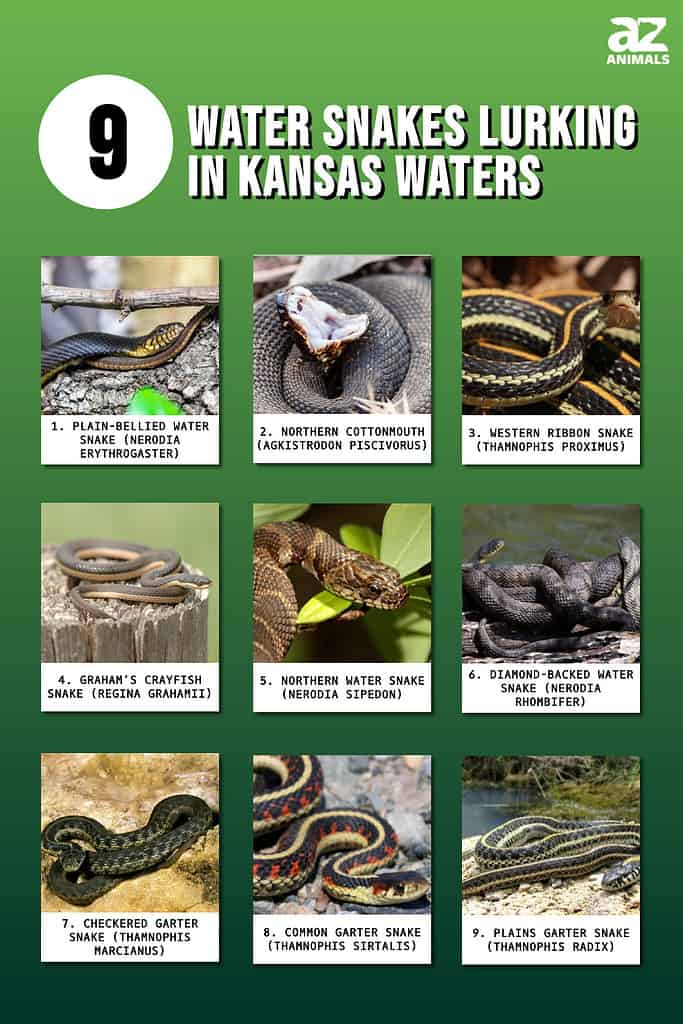
Despite being a landlocked state, Kansas has plenty of wetland areas. It is named after the Kansas River which flows though it, and the Missouri River makes up approximately 75 miles of the state’s northeastern boundary. Therefore, it’s not surprising to find that there are plenty of aquatic and semi-aquatic animals in the area — including snakes. There are 42 species of snakes in the state and nine of them can be found in and around the water. So, let’s learn about the water snakes in Kansas, including what they look like and which ones are dangerous!
1. Plain-Bellied Water Snake (Nerodia erythrogaster)
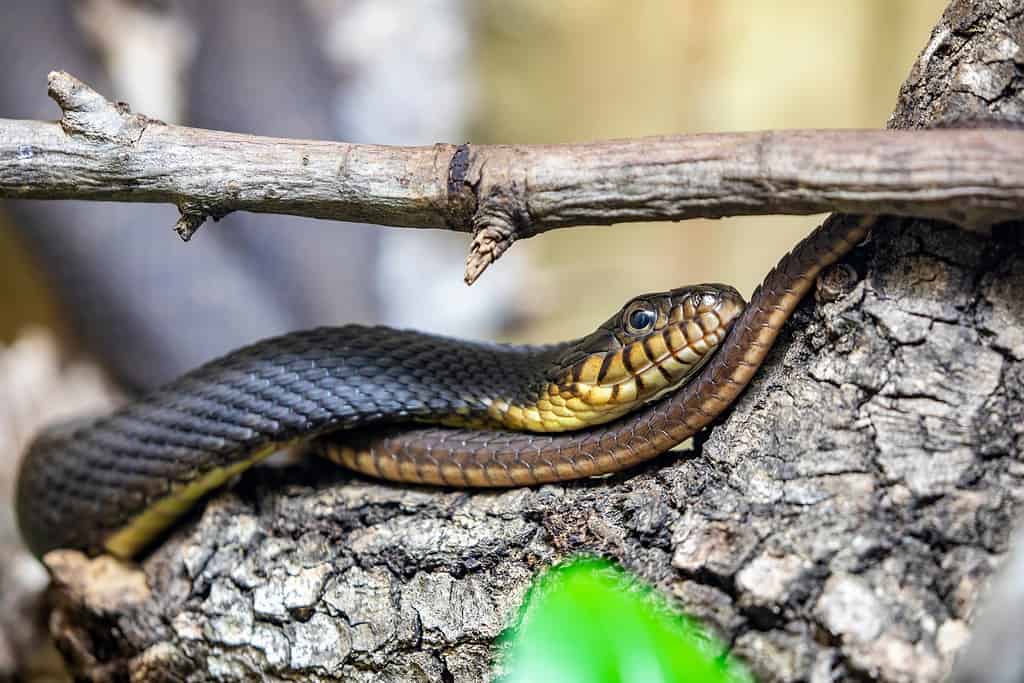
Plain-bellied water snakes are olive green with plain, unmarked bellies.
©Danny Ye/Shutterstock.com
The plain-bellied water snake is a fairly large snake which averages 30 to 48 inches long, although the longest specimen observed in the state was 55 inches long. Plain-bellied water snakes are typically olive green to brown with a plain yellow or cream belly. They occur in the southern and eastern region of the state where they live in swamps, ponds, and slow-moving streams. Plain-bellied water snakes prey mainly on frogs and fish which they swallow alive. They are not venomous but they may bite in self-defense if they are threatened. However, they will usually try to escape first — even across land.
2. Northern Cottonmouth (Agkistrodon piscivorus)
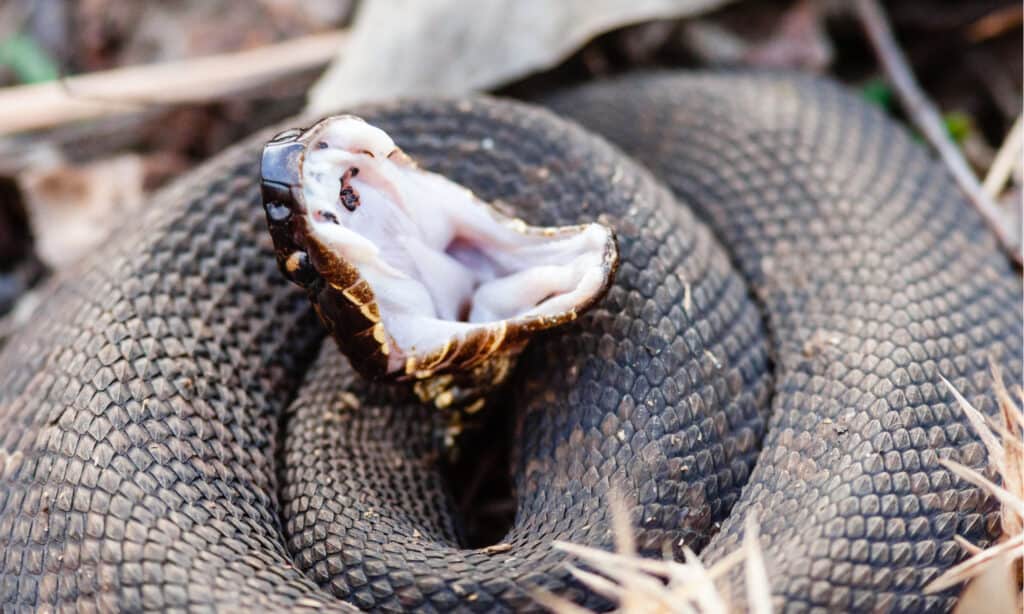
Cottonmouths often coil their bodies into a defensive posture and open their mouth wide to expose the distinctive white lining.
©Marcum Havens/Shutterstock.com
The northern cottonmouth is the only venomous water snake in Kansas and inhabits the far southeastern corner of the state in the Spring River drainage system. Cottonmouths reach approximately three feet long and are dark brown with a series of darker brown to black crossband markings. They also have a distinctive white lining inside their mouth which they often expose when they coil their body and open their mouth in a defensive posture. Cottonmouths possess cytotoxic venom which, although not typically fatal, does cause extensive tissue damage. These snakes prey on a variety of fish, amphibians, lizards, birds, and small mammals.
3. Western Ribbon Snake (Thamnophis proximus)
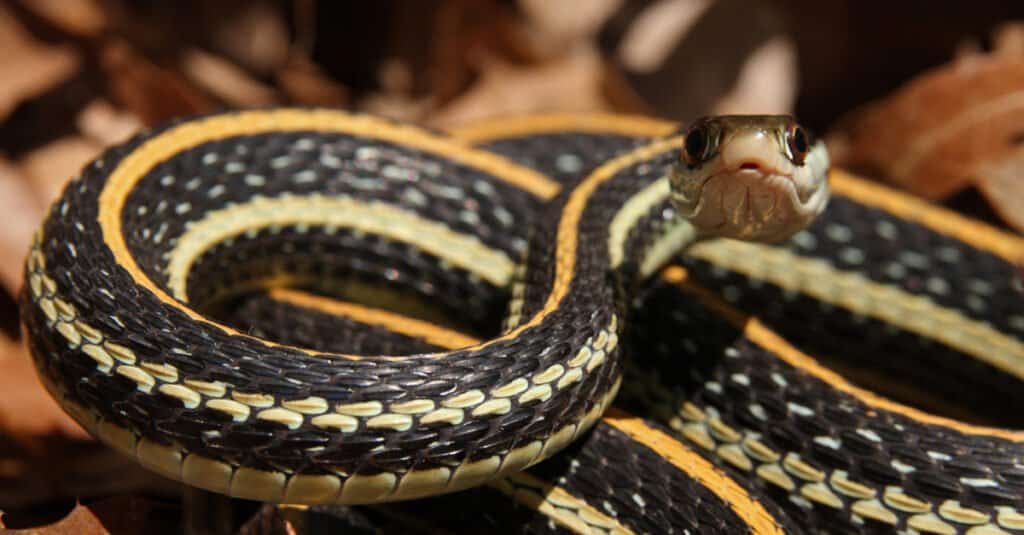
Western ribbon snakes often inhabit slow-moving areas of water.
©Ryan M. Bolton/Shutterstock.com
The western ribbon snake is a slender snake with a dark green, brown, or black body. These snakes also have three stripes — one in the center of their back, and one on each side of their body on the third and fourth row of scales. The stripe on their back is usually orange, while the lateral stripes are yellow or cream. Western ribbon snakes are fairly widespread across the state, although they are more common in the eastern region. They live close to slow-moving bodies of water, such as swamps, marshes, streams, and oxbow lakes. Western ribbon snakes are not dangerous to people and prey mainly on frogs and fish.
4. Graham’s Crayfish Snake (Regina grahamii)
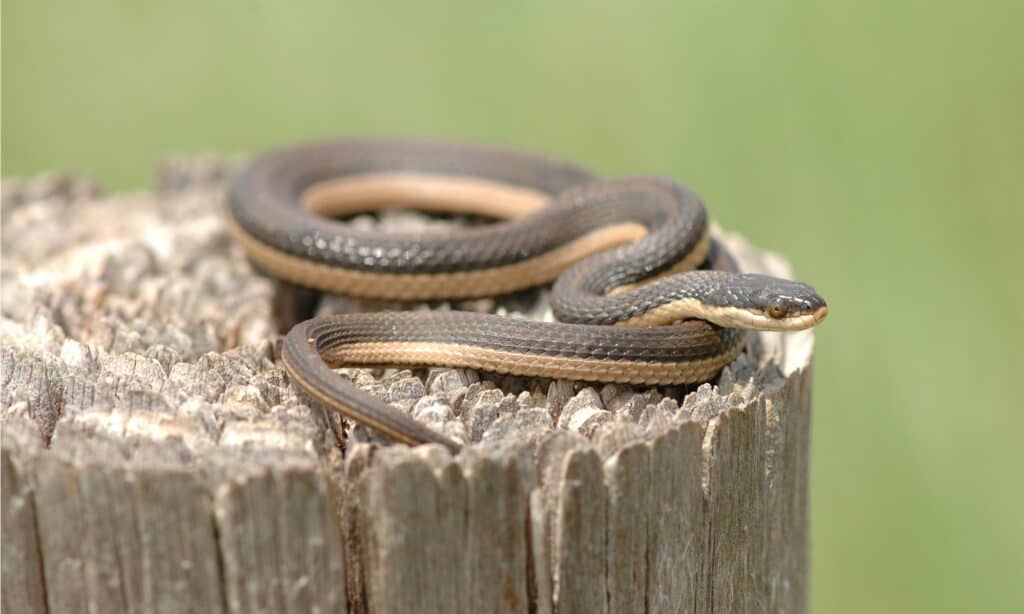
Graham’s crayfish snakes predominantly prey on crayfish.
©Rusty Dodson/Shutterstock.com
The next water snake in Kansas is Graham’s water snake which lives in the southeastern region of the state. Graham’s crayfish snakes average 18 to 28 inches long, although they can sometimes reach four feet long. They are gray to brown with yellow or cream sides from their belly to the fourth row of scales. Their belly is typically the same color but may have a row of dark spots in the center. Graham’s crayfish snakes inhabit lakes, streams, rivers, and marshes where there are plenty of crayfish for them to prey on. They are not dangerous but will flatten their bodies and release a foul-smelling musk if they are threatened.
5. Northern Water Snake (Nerodia sipedon)
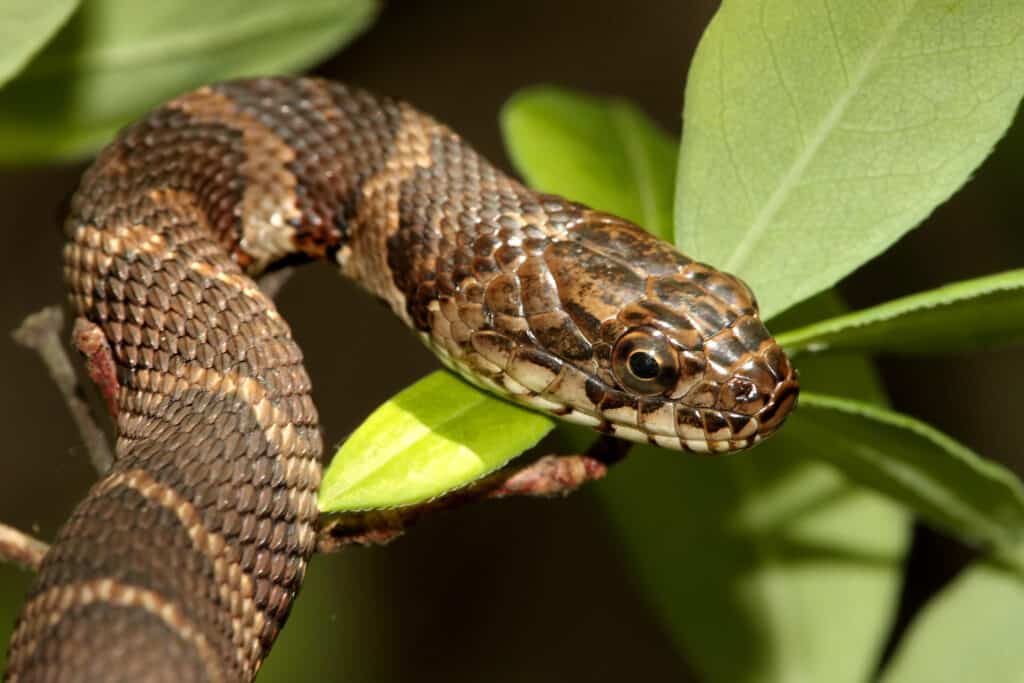
The northern water snake has broad crossband markings which eventually become blotches closer to its tail.
©Steve Byland/Shutterstock.com
Northern water snakes reach approximately five feet long and have dark brown bodies with darker crossbands and blotches. They have a similar appearance to the cottonmouth, meaning that they are often mistaken for them. However, northern water snakes are not venomous, although they can be extremely defensive if they are disturbed and may strike at the threat. Northern water snakes are widespread in the central and eastern regions of the state, but may also be found in scattered locations in the western area. They inhabit a range of wetlands, including swamps, streams, rivers, and lakes. They are rarely found far from water and prey on fish and frogs.
6. Diamond-Backed Water Snake (Nerodia rhombifer)
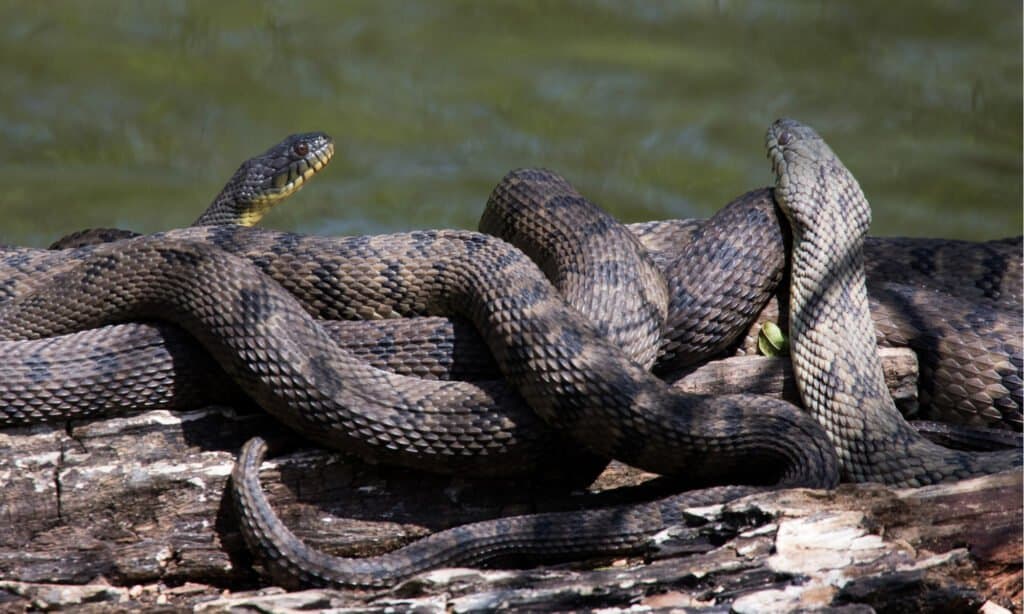
Diamond-backed water snakes have a distinctive diamond-shaped pattern on their bodies.
©Laurie L. Snidow/Shutterstock.com
Next, we have the diamond-backed water snake which is a large snake that reaches approximately 55 inches long. They are typically brown with black, diamond-shaped markings on their back. They also have a light brown or yellow belly with black, half-moon shaped blotches. Diamond-backed water snakes mainly live in the southeastern region where they can be found in streams, rivers, lakes, and swamps. They are active between March and September and can sometimes be observed basking near the shore. They are quick to flee back into the safety of the water if they are disturbed, but many bite as a last resort if they are cornered.
7. Checkered Garter Snake (Thamnophis marcianus)
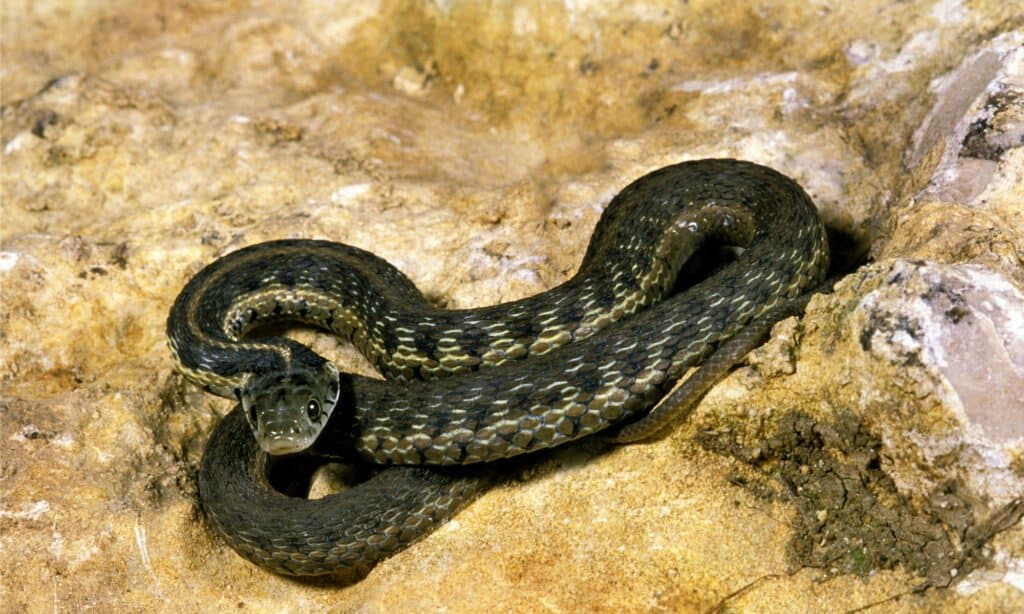
The checkered garter snake is aptly named for the black and white checkered pattern of scales running down its back.
©iStock.com/slowmotiongli
Another water snake in Kansas is the checkered garter snake which is a state threatened species. These snakes are only found in the extreme southern region, to the west of the Chikaskia River. Although they commonly inhabit areas close to water, they also sometimes live in grasslands and on hillsides. Checkered garter snakes prey on small fish, frogs, toads, and earthworms. They are slightly venomous, although it is not strong enough to be a danger to humans. Checkered garter snakes are 18 to 33 inches long and are dark-colored with three lighter stripes. Their lateral stripes are located on the second and third rows of scales. However, they also have dark spots which encroach on their dorsal stripe, creating a checkerboard pattern.
8. Common Garter Snake (Thamnophis sirtalis)
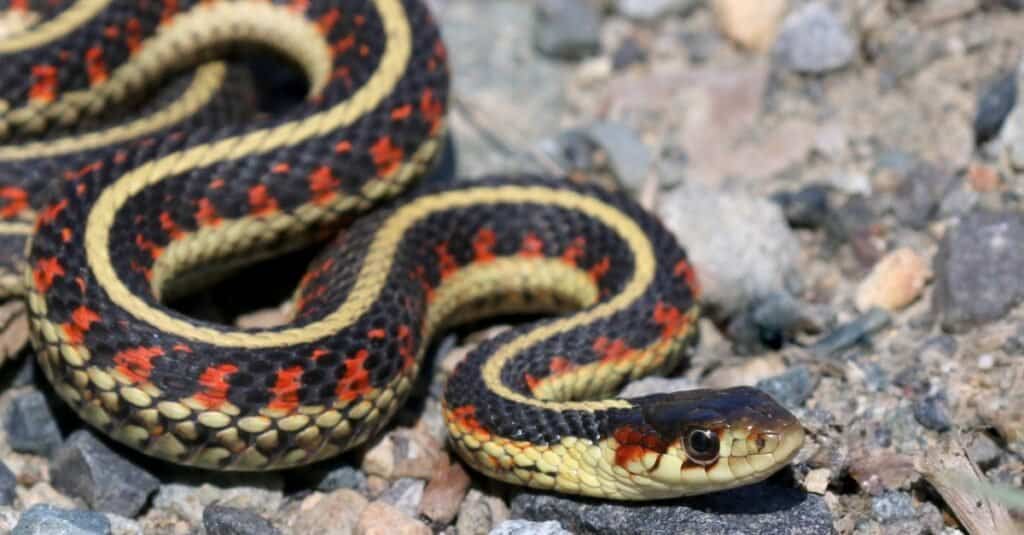
Common garter snakes are mildly venomous but it does not cause more than localized swelling and itching.
©iStock.com/randimal
The common garter snake is another garter snake which is closely associated with water. Common garter snakes live in the eastern two-thirds of Kansas and their aquatic habitats include swamps, marshes, ponds, and wet meadows. They can reach 48 inches long and have dark bodies with three distinctive stripes. Their stripes can be yellow, red, orange, cream, green, or blue. They also sometimes have bright red spots between their stripes. Common garter snakes mainly prey on amphibians, fish, worms, and slugs. They are not dangerous to humans but possess mildly venomous saliva which they chew into their prey to slow them down. They don’t usually bite, but if they do then they typically cause nothing more than localized swelling and itching.
9. Plains Garter Snake (Thamnophis radix)
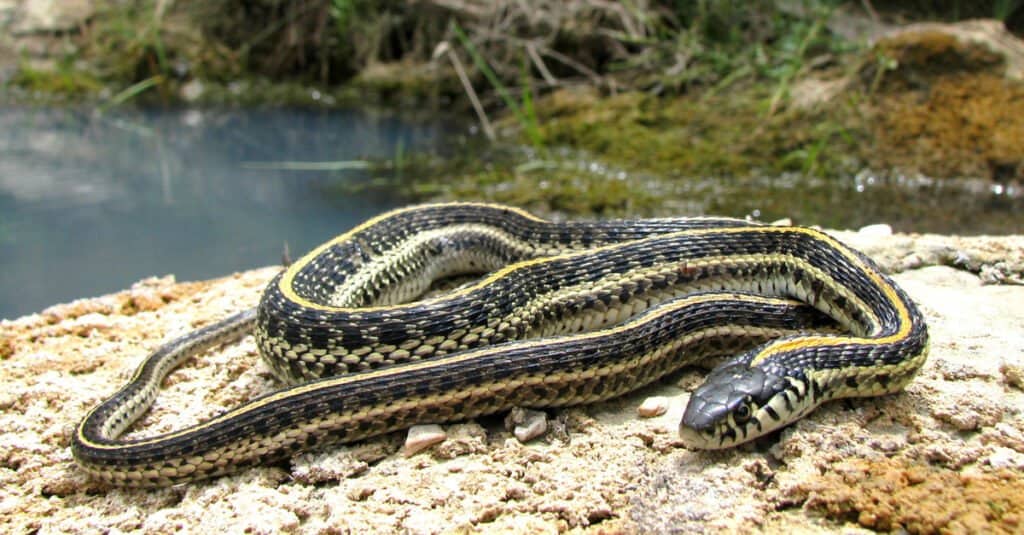
Plains garter snakes usually have a bright orange or yellow stripe on their back with pale stripes on their sides.
©Joe Farah/Shutterstock.com
Our final snake today is the plains garter snake which inhabits the majority of the state, with the exception of the southeastern corner. Plains garter snakes typically live close to swamps, marshes, streams, and ponds. They are approximately 42 inches long and are brown to greenish-gray. Like the other garter snakes, they have three stripes. However, their central stripe is usually orange or yellow, while the lateral stripes are paler and are located on scale rows three and four. They also have distinctive black markings on their lips and some yellow spots on the top of their head. Plains garter snakes are usually diurnal and are active between March and November.
Summary of the 9 Water Snakes Lurking in Kansas Water
Here are the 9 water snakes found in Kansas:
| Rank | Snake Species |
|---|---|
| 1 | Plains Garter Snake (Thamnophis radix) |
| 2 | Common Garter Snake (Thamnophis sirtalis) |
| 3 | Checkered Garter Snake (Thamnophis marcianus) |
| 4 | Diamond-Backed Water Snake (Nerodia rhombifer) |
| 5 | Northern Water Snake (Nerodia sipedon) |
| 6 | Graham’s Crayfish Snake (Regina grahamii) |
| 7 | Western Ribbon Snake (Thamnophis proximus) |
| 8 | Northern Cottonmouth (Agkistrodon piscivorus) |
| 9 | Plain-Bellied Water Snake (Nerodia erythrogaster) |
The photo featured at the top of this post is © Alyssa Metro/Shutterstock.com
Discover the "Monster" Snake 5X Bigger than an Anaconda
Every day A-Z Animals sends out some of the most incredible facts in the world from our free newsletter. Want to discover the 10 most beautiful snakes in the world, a "snake island" where you're never more than 3 feet from danger, or a "monster" snake 5X larger than an anaconda? Then sign up right now and you'll start receiving our daily newsletter absolutely free.
Thank you for reading! Have some feedback for us? Contact the AZ Animals editorial team.






